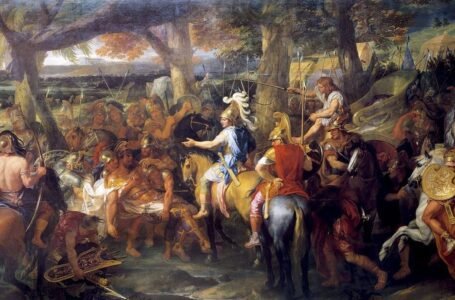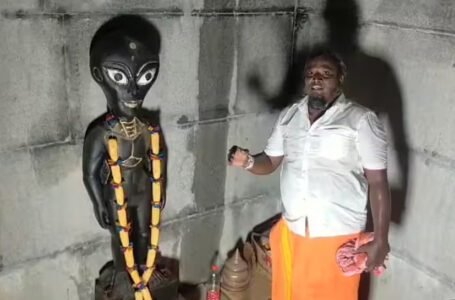Kali: The Fierce Mother of Time and Transformation
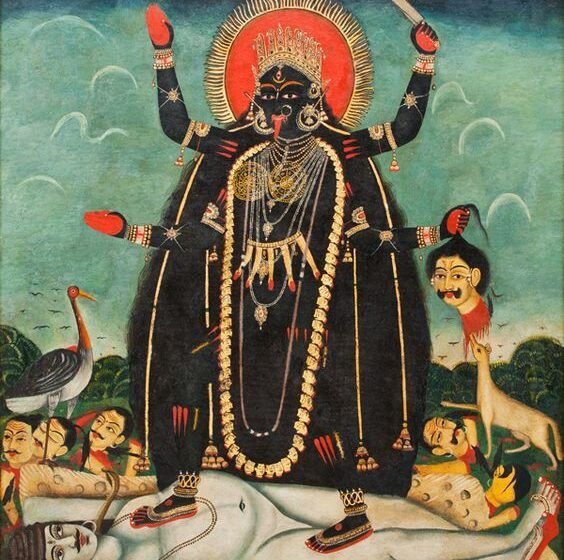
Within Shaktism, a denomination within Hinduism where the godhead is believed to be a goddess, Kali or Kalika is considered to be one of the major Hindu goddess. She is worshipped in Nepal and across South Asia. Kali also referred to as Kali Mata or the black mother is said to be tantric and non-Vedic goddess, but the word Kali can be found in the Atharveda—the fourth Vedic scripture. Kali was a major goddess, worshiped in the Pre-Aryan period and in the villages and mountains and tribal cultures of South Asia. She is known as the goddess of time, change, death, destruction; along with attributes of sexuality and is also viewed as the symbol of motherly love. Kali’s attributes are quite paradoxical in nature.

The origin or birth of the goddess Kali can be traced back to the most famous and widely known narration of the battle between the warrior goddess Durga and the demon Raktabija. The narration begins with Mahishasura or Raktabija, a very powerful demon who had obtained a boon from the god Brahma that he could kill any man or god. This led to the demon unleashing havoc in the heavens and the earth and the gods unable to defeat him, sought for Durga’s help. As the battle progressed between the warrior goddess Durga and the demon, her rage grew as each drop of the demon blood that fell to the group created a new demon. Realizing the need for an even more powerful force, Durga summoned Kali from her own forehead, symbolizing the unleashing of her most ferocious and untamed energy. As soon as Kali emerged she went on a rampage and devoured Raktabija and other demons, stringing their severed heads into a garland. The intensity of her anger made it impossible to stop her from slaying every wrongdoer. It was then when Lord Shiva, her husband lay down in her path, while Kali continued with her tandav or dance of destruction. The moment she realized she had been standing on Shiva, Kali was struck in shock and embarrassment and her tongue lolled out, ending her rampage.

In another narration, a demon named Daruka was causing trouble and a powerful demon like him could only be killed by a woman. To defeat him, the gods had asked Parvati the consort of Lord Shiva to defeat him. In order to do so, Parvati transformed herself into the fierce Mahakali. As Mahakali, she was able to display immense power and easily defeated the demon Daruka. A more historical narration of the goddess is linked to her worship by the sage Ramakrishna. Ramakrishna, a nineteenth century saint and mystic, worshipped Kali at the Dakshineswar Kali Temple near Kolkata. It is said that he saw Kali not just as a fearsome goddess but as the loving, compassionate mother of the universe. Ramakrishna’s intense devotion and mystical experiences with Kali profoundly influenced his spirituality. He described experiencing direct visions of Kali, feeling her presence as both terrifying and tender.
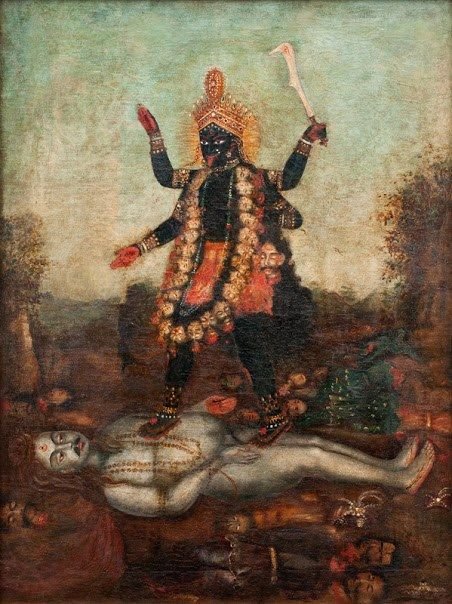
Kali, the goddess of time, transformation, death and sexuality is often depicted in Hindu iconography with dark blue or black skin, her bloody red tongue lolling out with a garland of severed demon heads adorning her neck. Kali’s iconography is full of symbolism. Her appearance as either black or blue skin symbolizes the infinite darkness and the eternal void from which all creation emerges and into which it ultimately finds its way back towards and dissolves. Her complexion signifies the vast, formless aspect of the divine which is said to be beyond human understanding. Her wild, disheveled hair stands for freedom from societal norms and the untamed primal nature of the universe as well as sexuality. Her hair depicts her form as a figure of pure and uncontrolled energy.

Kali’s four arms each carry symbolic items: a sword, a severed head, a trident, and a bowl or skull-cup catching the blood of the demons. Her sword represents the sharpness of knowledge that cuts through the veil of ignorance and worldly illusions. The severed head symbolizes the destruction of the ego, which is the main cause of most of the human suffering. The trident is a symbol of her power and divine energy, that Lord Shiva blessed her with, signifying the three gunas of nature namely: sattva that is purity, rajas meaning activity, and tamas that is inertia. The skull-cup catching the blood stands for her role in transforming and absorbing the negativity of the universe and purifying it. It also stands in correlation to her battle and victory over the demon Raktabija.
Her garland of skulls and her skirt of severed hands depict death, destruction, and the annihilation of the ego. The skulls also represent the continuous cycle of life and death, as Kali is the goddess who provides moksha by bringing an end to the cycle of rebirth. On the other hand the severed hands signify karma and the deeds of human beings which she transcends.

Kali’s dual nature as both a destroyer and a mother is central to her worship. Her terrifying attribute, though is significant to her battle and rage against the demons, she is also worshipped and loved as a benevolent mother goddess. In Bengal, she is worshipped as Ma Kali, who is the compassionate and loving mother protecting her children and nurturing them. Kali throughout India and other regions is worshipped in various ways. From being the most revered goddess of the esoteric Tantric practices to huge festivals, she is celebrated largely.
In tantric traditions, Kali is believed to be the ultimate reality. Tantric worships often involve intense practices in order to achieve the oneness of the universe. Devotees in this esoteric practice engage in rituals that centre and lean more towards meditation, chanting of mantras, and offerings. In Kali’s worship, the devotees use the Kali mantra, which is believed to invoke her power and energy. These rituals sometimes also include the use of Yantras a geometric design which is a combination of both masculine and feminine energy, and mudras to bring in the divine energy.

Kali puja is one of the major festivals dedicated to Kali. This festival is mostly celebrated in Bengal, Assam, and Odisha. This festival often coincides with the festival of Diwali which indicates the victory of light over darkness. During Kali Puja, the devotees of the mother goddess create elaborate altars and sculptures of the goddess. Rituals are performed throughout the night, a night of new moon, invoking the goddesses’ blessings and protection. Offerings of flowers, fruits, and sweets are made.
Apart from the festivals, a large number of temples across India are dedicated to Kali. Some of the famous Kali temples include the Kalighat temple and the Dakshineswar Kali temple in Kolkata. In these temples, daily rituals are conducted and offerings are made to the goddess. Devotees often light lamps and incense, chant hymns, and recite prayers, seeking her blessings. Kali as a goddess and the most powerful feminine figure traverses beyond religious realms and into the world of literature and art. Kali is an important figure in many classical texts and poems, especially in Bengali literature. The works of poets like Ramprasad Sen and Kazi Narzul Islam celebrate her fierce and compassionate aspects, depicting her as the ultimate protector and destroyer of the evil. In the play Hayavadana by Girrish Karnad, Kali is portrayed in a rather modern form, reflecting the ideals of the post independent new woman of India. In the play Kali acts as the goddess of change and transformation and stands as a form of female sexuality. In visual arts, Kali has been depicted in various styles, from traditional paintings to contemporary art.
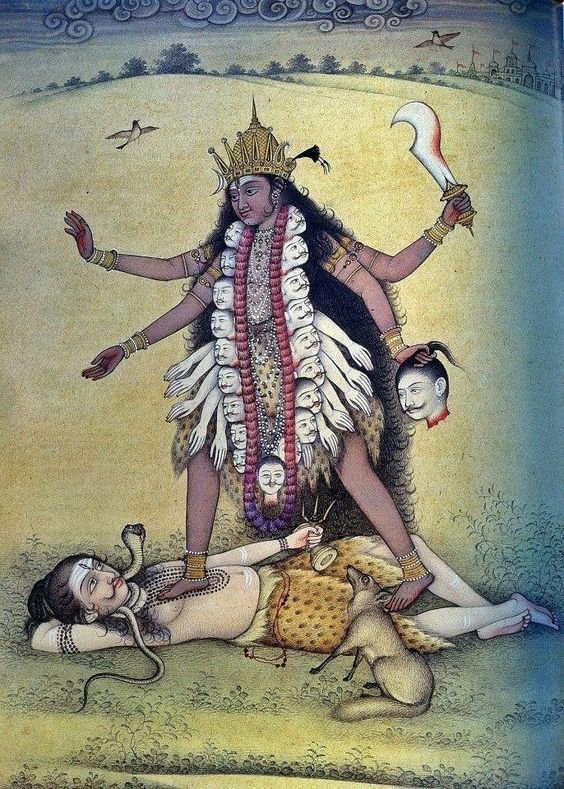
Kali’s name is derived from the Sanskrit word “Kala,” meaning time. This association reflects her role as the personification of time, its cyclical nature of creation, preservation, and destruction. Time and Kali also signify the inevitability of change and the transient nature of existence. The myths, legends and attributes continue to inspire not only her devotees but people all around the world even today, showcasing her consistent legacy in Hindu spirituality and mythology. As a bold symbol of fierceness, change, time, violence and sexuality, Kali stands as the revered deity of Hinduism.

